We test the Specialized Turbo Levo Alloy, the most economical of the range.
In the world of E-Bikes we have witnessed a meteoric evolution, within its short existence. But if we have to name a model that defined a before and after, it would be without a doubt the appearance of the Specialized Turbo Levo back in 2015. A bike that introduced concepts such as the integration of the motor and battery as never seen before.
Today the Turbo Levo is in its third generation and continues to be a benchmark in terms of innovation and performance. We have had the opportunity to thoroughly test its entry-level model to see if, at a reasonable price, we can enjoy the virtues of one of the most acclaimed E-Bikes.
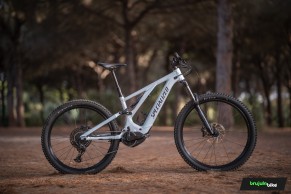
Specialized Turbo Levo Alloy: multiple arguments to remain the benchmark
The third generation of the Turbo Levo does not offer any major aesthetic changes compared to its predecessor, but in this case the saying looks can be deceiving is true.
RECOMENDADO

How to lose body fat? Differences between losing weight and losing fat

When must the tubeless tire sealant be replaced? What quantity?

The real importance of signing up for a race
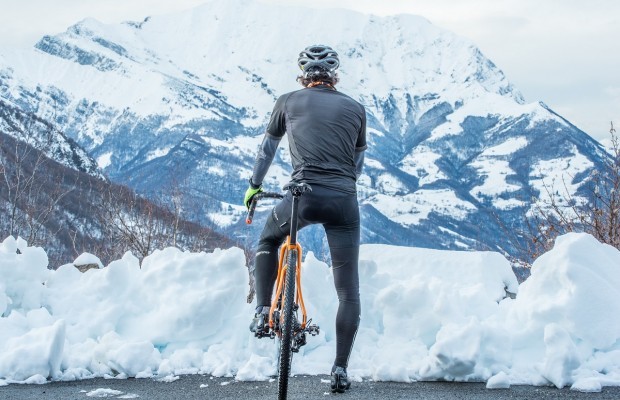
Don't overlook your nutrition when training in cold weather

The best apps for cycling and mountain biking

25 cycling gifts ideas to get it right
To begin with, this eMTB adopts the mullet concept, combining a 27.5" rear wheel with a 29" wheel at the front. A system that gets the best out of both sizes. The 29" front will favour the passage through obstacles and will optimise stability and grip, while with the 27.5" rear we have a more compact swingarm, with short chainstays, which will give more agility to a bike that, due to its E-Bike characteristics, will be very grateful for it.
The biggest differences from the previous generation are in the geometry of this new Turbo Levo. In general it has been updated in line with trends, moving a little more towards the enduro side, but as we will see, with the customisation options of its geometry we find ourselves with a very versatile bike, which we can adapt to the use we intend to give it.
In addition to this, the S-Sizing system has been adopted. This means that the down tube varies very little in each size so that we are not limited to a specific size depending on our leg length. In this way we can opt for a larger size if we prefer greater stability, or choose a smaller size if we are looking for a more manageable bike. Leaving aside, for the moment, the changes it allows us to make, let's see what we find as it comes out of the box.
The steering angle goes up to 64.5º (1.5º more relaxed than the Gen2) and the saddle angle goes up to 76.7º.
The reach has also grown and in size S3 (which would correspond to a M) it measures 452mm. The 27.5" rear wheel has made it possible to shorten the chainstays to 442mm. Thanks to this, the length between axles, despite growing due to the rest of the measurements, is not exorbitant, remaining in size S3 at 1225mm.
As we can see, the Turbo Levo is now more capable of tackling enduro use, although it is classified as a Trail bike, as in Specialized's range we have the Turbo Kenevo for those aggressive uses.
But as we have already mentioned, this does not stop here, as we have two geometric adjustment points that result in 6 different geometries.
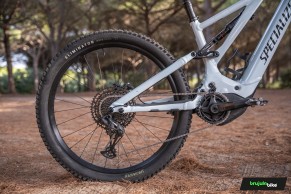
First of all we can vary the steering angle by 1°. Either making it more vertical or throwing it even more. This is achieved by changing the upper steering cup for another eccentric that comes as an accessory and, depending on how we place it, it will vary that degree in the direction we are looking for. At the moment, with this adjustment, we can choose between 3 different steering angles.
And the other point of adjustment is in the chainstays, where we find a flipchip, with which we can lengthen the length of the chainstays by 6mm, at the same time that we lower the bottom bracket by 7mm and the headset is launched approximately half a degree more.
As we can see, Specialized has ensured that the Turbo Levo can be adapted to a wide range of uses, from the most radical enduro to touring without aggressive pretensions.
In terms of frame construction and main lines we do find similarities with its previous version. The Turbo Levo is one of the most attractive E-Bikes on the market for our taste.
Its suspension gives 160mm of travel at the front and 150mm at the rear, with the rear suspension being a 4-Bar suspension based on the kinematics of its muscular Stumpjumper EVO model, but adapted to the characteristics of an E-Bike like the Turbo Levo.

Aesthetically, the Side Bar is striking, which is the reinforcement next to the shock absorber, and also the fact that the down tube is not extremely thick, as is the case with other E-Bikes capable of holding large batteries (in the case of the Turbo Levo, up to 700Wh, although our model has 500 Wh). However, the motor area looks very bulky, and that's because the lower part of the battery and the motor share this space. This not only makes the rest of the frame look a bit sleeker, but also lowers the centre of gravity considerably, which will greatly improve the bike's handling.
Finally, a couple of details that we really liked about this Turbo Levo are, on one hand, the connection of the motor to the battery (which at the same time is the charging port). It is very well finished and sealed to keep water and dirt out, and at the same time it is very easy to use.

The other detail, which may seem minor, is that they have redesigned the internal cable routing of the seat post, and now it is easy to raise or lower the saddle and the cover slides inside without any problem.
The most powerful and customisable motor on the market
Yes, with 90Nm of maximum torque and an assistance that can multiply by 4 the power that we exert on the connecting rods, we are looking at what is, on paper, the most powerful motor that has ever passed through our hands.
In this new version, the Turbo Full Power System 2.2 motor has a more robust and durable belt and new firmware in search of a more natural pedalling. But as each user may have different preferences and tastes, from the Specialized Mission Control application we can adjust a series of parameters that will make the engine behave just as we want, and we can even vary the settings just by opening the application in the middle of our route.
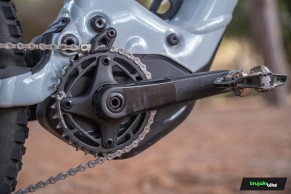
From the Mission Control app we can vary the level of assistance for each mode (Eco, Trail and Turbo) in 10% increments. Peak power can also be adjusted for each mode.
For those who are not familiar with these settings, we will say that the assistance always varies according to the force we apply to the pedals. If we have a high assistance it will multiply our power to a greater extent, and with low assistance it will not give a lower percentage, but it will always increase if we increase our effort. The limit of this increase is the maximum power that the engine is capable of giving and, in principle, we can reach this maximum power whatever the level of assistance we are using, the only difference will be the effort we have to make to reach it.
With the Peak Power setting, we can limit the maximum motor power in any of the modes, so that we will reach a point where, even if we continue to exert more force, the motor reaches the limit we have set. Using this setting, depending on the type of route we are going to do, will allow us to save battery power.
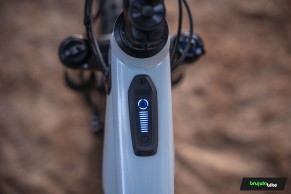
Another very important setting that the Turbo Levo allows us to make is the Acceleration Response. With this setting we choose whether we want a very smooth power delivery at every start, or on the contrary, we want the engine to deliver its power almost immediately. This can change the behaviour of the bike completely, making it more docile and governable or turning it into a racehorse.
When tackling uphill trials it is a vital adjustment, because if the response is too slow it may not give you enough time to provide the bike with enough inertia to overcome the first obstacles. And if we go to the opposite extreme, it can be difficult to control a bike with this power at every start and the rear wheel can easily slip.
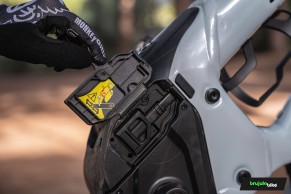
With the Turbo Levo we have the advantage of being able to adjust this parameter in 10% increments and get the bike to suit our preference.
With the Mission Control application we can adjust another parameter. This is the Shuttle mode, which is deactivated by default but can be increased to the level we want. According to Specialized it is something like an extra help to activate it when we are very tired from a demanding route and to be able to finish it with less effort.
Specialized Turbo Levo Alloy: a very successful entry-level set-up
This is the most economical model in the Turbo Levo family, but that doesn't mean there aren't components that won't be up to the aggressive use this bike is expected to be put to.

For the suspension we have the entry-level models from Rock Shox. At the front, the Rock Shox 35 Silver fork with 35mm bars ensures good stiffness, although its sensitivity is not up to the level of the top models. The Rock Shox Deluxe Select R shock lacks a lever to vary the compression but also offers a good behaviour.
The drivetrain combines Sram NX Eagle components with SX Eagle derailleur and shifting. This combination is the most affordable for accessing Sram's 12 speeds. Its operation, as we shall see, is more than correct, although it does not enjoy the finishes of superior groupsets.
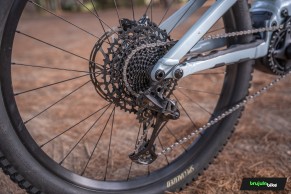
Sram G2 RE brakes, with their 4 pistons and 200mm discs, guarantee safe braking in all conditions.
The brand's own wheels combine solid-looking hubs and sealed bearings with a 30mm internal width aluminium rim. Both wheels have 28 DT Swiss spokes.
As already mentioned, the front is 29" and the rear is 27.5". Specialized tyres are mounted on them. Butcher model at the front and Eliminator at the rear, both with Grid Trail casing and 2.6" width.
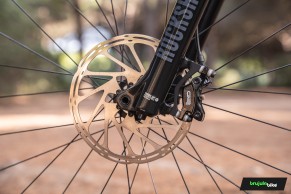
The dropper seatpost is a Tranz X dropper with a 34.9mm diameter and its travel varies depending on the size, being 150mm the one we had on our test unit. We've tried this seatpost before and its performance is excellent.
Of the rest of the Specialized components, the handlebar-stem set with a 35mm diameter and good finishes and the Bridge Saddle stand out, which, being Specialized and its Body Geometry, is a real guarantee of comfort.
Testing the Specialized Turbo Levo Alloy
When our test bike arrived, at first glance it didn't look much different from the previous version. It's on closer inspection that we found the differences, apart from the 27.5" rear wheel, which is something that is very noticeable.
This is something we liked, as the Specialized Turbo Levo is one of the most aesthetically pleasing E-Bikes. And the finish, even in the aluminium version, is well thought out down to the last detail.
As always, we took it on our scales before putting the pedals on, and the figure we got was 23.68 kg which, for the entry-level version of the range, we think is a very good figure, bearing in mind that this is one of the most powerful E-Bikes.
After adjusting the position and pressures, we set off on our first pedal strokes. We feel comfortable from the very first moment. The reach has increased but we still have a fairly upright position thanks to its short stem.
The first sensation we get from the motor is one of tremendous smoothness, without the sharp thrust that other engines offer. This is because the throttle response is set to minimum, but we can vary it to our liking. We ended up leaving it at 40%, where we found a good compromise between agile starting and easy handling.

Once on the road, we played with the assistance levels and were able to see the tremendous power that the motor has to offer. In ECO mode the motor is very quiet, and as we increased the assistance there is a humming noise, but within this category of engines it seems to us to be one of the quietest.
We wanted to check what the use of Shuttle mode means, as the explanation given for this setting is somewhat lacking. To do this we linked the Turbo Levo to our Garmin and put on the screen the data of the power exerted by us. We then did different tests on the same climb and in different assistance modes with and without Shuttle activated.
As soon as we started, we noticed that with the Shuttle activated at 100% it was considerably less difficult to accelerate from a standstill, and then on the climb we saw in each mode how the power we exerted was less for the same speed.
The conclusion we draw is that it gives a plus of assistance at all levels compared to how they are adjusted, and could be useful, as Specialized says, for that day when we finish tired and we want an extra help on the last climb (if there is battery left for it of course...).
Turbo Levo 3rd Generation: the total eMTB
Now it's time to put the Turbo Levo to the test on all types of terrain and see how much its geometry has improved and how much the adjustments it offers can do. It comes standard with a neutral steering cup that leaves the steering angle at 64.5° and the rear flipchip setting at High (short chainstays).
With this setting we find a very balanced bike. The handling on climbs or pedalling sections is quite good, and when the terrain slopes down we feel a great security, it gives us confidence to let the bike run in compromised sections. The corner entry is also surprisingly good for a bike of this weight. The fact that it is a Mullet has a lot to do with this.
On fast, broken sections the geometry helps and, although the suspension does its job reasonably well, you can tell we don't have a premium set-up in this respect. Even so, the Turbo Levo gave us total confidence on downhill sections.

Once adapted to the bike we tested the geometric adjustments. We changed the neutral steering cup for the eccentric one. This operation is really simple, only loosening the headset and removing the stem is necessary for the change, unlike other bikes where you also have to change the lower cup and remove the fork. In addition, the cup is made of aluminium and gives the impression of a reliable and durable design. Once with the eccentric cup, to change the direction and change from -1º to +1º we don't even have to remove the stem completely, just loosen it and lift it a few millimetres.
We first tried the +1° position, leaving the steering at 65.5°. Here we noticed a clear advantage in certain situations, such as pedalling and riding on easy trails. The bike moves better and feels much more agile.
We also noticed a significant improvement on a very technical trail with constant uphill and downhill, where we put all the E-Bikes that pass through our hands to the test. Here the agility of the Turbo Levo with the 65.5° angle made us tackle every step with astonishing ease. In general, this setting seems to us to be very suitable for anyone who does not intend to tackle very dangerous and steep descents, or to reach top speeds on descents.
As it could not be otherwise, we tried the opposite setting. We turned the cup to leave the angle at 63.5º. The change is felt instantly and it doesn't take much feeling to notice the difference in behaviour. Now the Turbo Levo is a little more clumsy at low speeds. In pedalling areas it's a little more difficult to get the bike on the exact line we want, but as soon as the speed increases, things change.
It was only after starting to ride down the most aggressive trails that we noticed an unbelievable confidence. Both on steep, technical sections and on very fast trails the Turbo Levo feels like a real enduro.
This setting will be preferred by those who are looking for the more enduro side of the bike and take the climbs as a link to the next downhill.

We are missing the flipchip adjustment which, if we set it to Low and lengthen the chainstays, together with the steeper steering angle, the stability we get with the Turbo Levo reaches a higher level. We find this setting feasible on bike park type downhills where we can tackle bankings and jumps with a lot of safety. In all other situations and more natural descents we find it more logical to use the flipchip as standard.
Final conclusion
After a season in which we have been able to enjoy the Specialized Turbo Levo Alloy, we have been able to see how the evolution that this model has undergone makes it once again a benchmark in the world of E-Bikes. The customization that can be achieved on the Turbo Levo, both in terms of motor performance and geometry, means that whatever our preferences, we can find a bike that adapts to our style.
Furthermore, testing the most economical model shows us that, from the first entry level of the range, the Specialized Turbo Levo has shown us that it has many arguments to be considered a reference.
Specialized Turbo Levo Alloy: specifications, weight and price
- Frame: Specialized M5 Premium Alloy, S-Sizing, 150mm travel
- Fork: RockShox 35 Silver, S1: 150mm, S2-S6: 160mm
- Shock: RockShox Deluxe Select R
- Rear derailleur: Sram SX Eagle
- Cassette: Sram NX Eagle, 11-50
- Chain: Sram NX Eagle
- Shifter: Sram SL SX Eagle
- Crankset: Praxis forged M30, 160mm
- Chainring: Sram X-Sync Eagle, 32T
- Hubs: Alloy sealed cartridge bearings, 12x148 / 15x110
- Rims: Specialized hookless alloy, 30mm inner wide, tubeless ready
- Front tyre: Specialized Butcher, Grid Trail, T9, 29x2,6”
- Rear tyre: Specialized Eliminator, Grid Trail, T7, 27,5x2,6”
- Brake: Sram G2
- Stem: Alloy Trail Stem, 35mm bar bore
- Handlebar: Alloy, 35mm diameter, 780mm
- Saddle: Specialized Body Geometry Bridge
- Seatpost: TranzX dropper. S1: 100mm, S2: 125mm, S3: 150mm, S4-S5: 170mm, S6: 200mm
- Motor: Specialized Turbo Full Power System 2.2
- Battery: Specialized M3 500Wh
- Weight: 23,68kg
- Price: 5.500€